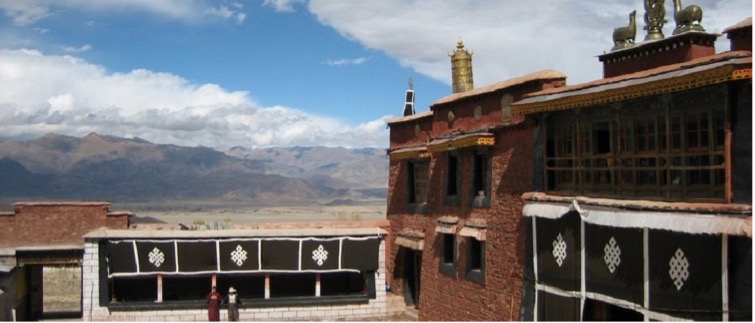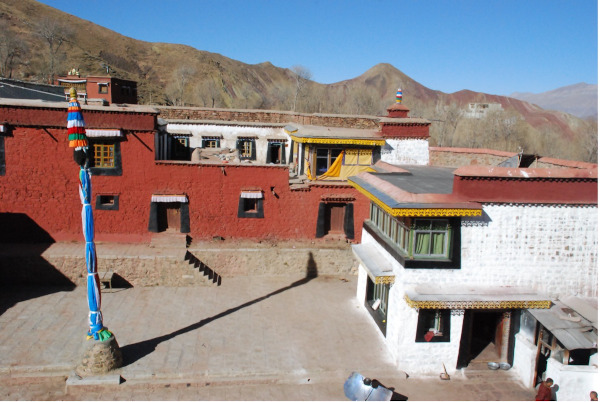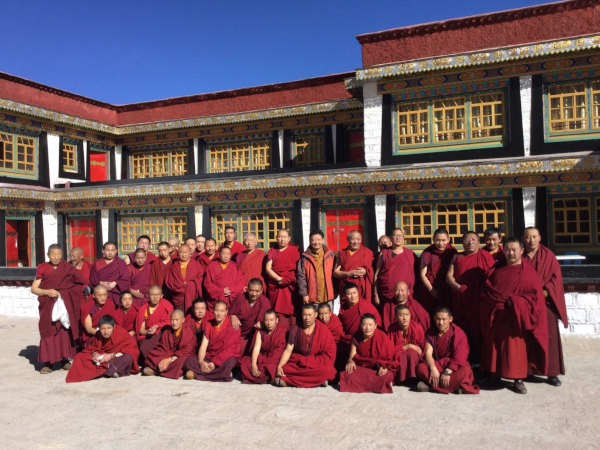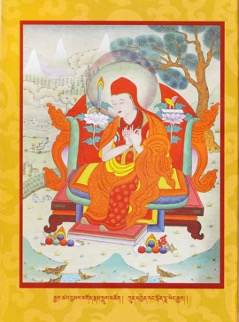
The late Kyabje Chogye Trichen Rinpoche was the twenty-fifth patriarch of Phenpo Nalendra Monastery and was the head Lama of the Tsarpa branch of the Sakya school. Although Phenpo Nalendra predates the formation of Tsarpa lineage, it is one of the main monasteries of the Tsarpa tradition, and is located in the Phenyul Valley just north-east of Lhasa in central Tibet.

Founded in 1435 by one of the great masters in the history of the Sakya tradition, Rongton Sheja Kunrig (1367-1449), Nalendra is one of the most important Sakya monasteries, with branch monasteries in various parts of Tibet, from Tsang to the Amdo region. Named after that incomparable centre of classical Buddhist learning (Nalendra Monastery in Bihar, India), during its first twenty years Nalendra grew to house 3,000 monks. ‘Rgyun gyi dbang po’ (the Tibetan word for Nalendra) means “the river of power” and describes well that over the course of more than 500 years, Phenpo Nalendra came to be one of the greatest Sakya Shedras (colleges) in U district of central Tibet.
The monastery generally had between 700 to 1,000 resident monks, and was also home to thousands of visiting monks who were studying at the various colleges. As a stronghold of the esoteric practice lineage within the Sakya tradition, Nalendra became the principal monastery of the Tsarpa branch, due to the extraordinary masters of the practice lineage who were its throne holders. It was also a repository of the teachings of all the eight great practice lineages of Tibet and thus was a centre of the broader, non-sectarian approach to Buddhist practice. As just one recent example of this, the previous Chogye Trichen, throne holder of Nalendra, was a close disciple of the Fifteenth Karmapa, Khakyab Dorje, receiving in particular many teachings in the tradition of the Great Perfection (dzogpa chenpo), such as the Precious Collection of Revealed Treasures (Rinchen Terdzod).
Great meditators from all branches of the Sakya school went to Nalendra Monastery for practice and retreat. In modern times, prior to 1959, they came to train in the practice of retreat at Nalendra as disciples of Dampa Rinpoche, Zhenpen Nyingpo of Ngor, Zimwok Rinpoche of Nalendra, and Chogye Trichen Rinpoche. There were many retreat centres in the surrounding mountains, including two special hermitages where yogis remained in lifetime retreat. Whenever one of these yogis passed away, the event was inevitably accompanied by the appearance of rainbows, miraculous signs and wonders. A monk who came out of Tibet with Chogye Rinpoche remarked that this was so commonplace that the monks would say: “Well, of course he had signs, he stayed in lifelong retreat!’ Nalendra was renowned in Tibet for the practice of the female tantric deity Vajrayogini. There were said to be generation after generation of yogis who accomplished the fruition of ‘going to the celestial realms’ (khacho) through the practice of Vajrayogini in the form of Naro Khachoma. Through Vajrayogini, they were able to transfer to the paradise of Khechara, the Akanishta pure realm of the Sambogakaya buddha-fields. Some dissolved their physical bodies into rainbow light at the time of death. Some left this world with their physical bodies and accompanied Vajrayogini into the sky, disappearing into space as they journeyed to her pure realm. Some met her whilst moving amongst people and departed with her to the Khechara pure land; and for some, her coral staircase appeared in their meditation rooms and they ascended to Vajrayogini’s pure land. Many of the Chogye Trichen Rinpoches have displayed the signs of Khechara.

The previous Chogye Trichen, Rinchen Khyentse Wangpo (1869-1927), manifested signs of phowa, the transference of consciousness to Vajrayogini’s paradise, at the time of his passing from this world. Only recently, when the Khenpo Tsultim Gyalsten was cremated in Nalendra many bone relics bearing dots of sindura powder were discovered and his heart, tongue and eye remained un-burnt. After the relics were consecrated, there was a spectacular snowfall of lotus flowers, dharma wheels and dharmakara. Monks spread their robes and these wonderful symbols fell onto them –this has been captured on video camera.
Rongton Sheja Kunrig

The founder of Nalendra monastery, Rongton Sheja Kunrig, also known as Kunkhyen Rongton, was born in eastern Tibet in Gyalmo Rong in 1367. Guided by prophecies, as well as on his activities, Rongton was regarded as an emanation of Maitreya, the next Buddha of our fortunate eon. His earlier incarnations included the Indian acharya Haribhadra, Pandita Kamalashila, Phadampa Sangye and many others. He became known as one of the ‘six gems of the Sakya tradition’ in recognition of his unparalleled mastery of the sutra tradition in general, the scriptures of Prajnaparamita and the teachings of Maitreya in particular. His Eminence Chogye Trichen Rinpoche received Rongton’s teachings on the Prajnaparamita from the great bodhisattva Khunu Lama Tenzin Gyaltsen, as well as from other masters.
Rongton wrote three hundred works, ranging from eulogies and philosophical treatises to commentaries on the tantras. He was known to have realised, at the very least, the sixth bodhisattva level of spiritual attainment (bhumi), and it is said that he realized the truth of the nature of reality (Dharmata). According to his biographies, Rongton could send forth multiple emanations of himself, resurrect deceased beings and fly in space. As he entered the higher stages of realization, he became more and more childlike. He had liberated conceptual thinking and so behaved and spoke with the innocence of a child. He was a great bodhisattva and a great tantric master.
A contemporary of Tsongkhapa, the founder of the Gelug school, Rongton was the first to challenge the Gelug philosophical teachings. His students Gorampa and Shakya Chogden composed penetrating refutations of Tsongkhapa’s interpretation of Madhyamika. Nonetheless, Tsongkhapa held Rongton in the highest esteem, revealing to his student Khedrup-je that he regarded Rongton as none other than the bodhisattva Maitreya.
At the age of eighty-four, Rongton announced that he was to depart for Tushita heaven, where the bodhisattva Maitreya dwells. A few days later he passed away, dissolving into Maitreya. Rongton manifested one of the varieties of rainbow body at his passing, whereby the physical form dissolves into a body of rainbow light. His body shrank to a very small size and became extremely light. Before it completely disappeared, it suddenly stopped shrinking and then turned into a jewel relic, becoming again somewhat heavier. The tradition is that Rongton’s fruition of rainbow body was probably a result of the practice of Vajrayogini even though, as a manifestation of bodhisattva Maitreya, many means of manifesting the rainbow body were available to him.
History of The Chogye Trichens
Following the initial era of the founding of Nalendra, Dakpo Tashi Namgyel became the successor to Rongton followed by Gewa Gyalsten and Gung-ru. After the 7th abbot of Nalendra, some misfortunes and outbreaks of illness befell Nalendra monastery. In response, the twenty-first Sakya throne holder, Dagchen Lodro Gyaltsen (1444-1495) determined that the abbot and throne holder should not be solely a great tantric adept, but that they should have attained the level of a bodhisattva, in accordance with the Mahayana Buddhist vehicle. Thus, Khyenrab Choje (1436-1497) of the Zhalu Kushang branch of the ancient Che family was installed as the throne holder and eighth abbot of the monastery. Khyenrab Choje was the first Chogye Trichen and was succeeded by seventeen holders of the Chogye Trichen title, all of whom came from the Che family, from the ‘bone lineage’ of patrilineal descent. This included Zimwok Tenzin Nyendrak. From the time of Khyenrab Choje until the Chinese invasion of Tibet, Nalendra suffered no further obstacles.
The Nalendra throne holder’s title, Chogye Trichen, is composed of two terms: chogye, ‘eighteen’; and trichen, ‘great throne.’ It is said that the name Chogye is derived after the passing away of Khyenrab Choje, who was the first holder of the throne at Nalendra to come from the Zhalu Kushang family. Khyenrab Choje was invited to go to China by the Chinese emperor. As he was unable to go he sent his nephew, Jamyang Donyo Gyaltsen, as his representative. Through this nephew, the emperor bestowed the title of Chogye Trichen on the throne holder of Nalendra, lauding eighteen (chogye) exalted spiritual qualities he wished to recognize in Khyenrab Choje. The ‘eighteen’ in this title also alludes to the 18th of the 12th lunar month which celebrates the anniversary of Khyenrab Choje. This day is also marked by the Chogye Tripa (throne holder) bestowing the Goddess Parnashavari empowerment, which is given annually to remember and honour the anniversary of the ending of the epidemic that devastated Nalendra.
The Chogye Trichens received many offerings from the Chinese emperors. One offering was the ceremonial hat, a copy of which Chogye Rinpoche is often seen wearing in photos. This hat is replete with symbolism of Vajrayana Buddhism in general and of the deity Hevajra in particular. The famous hat was named “only ornament of the world” by the emperor. Subsequent holders of the throne of the Chogye Trichen continued to receive many honours from the Chinese emperors.
Whilst in meditation retreat in the Potala in Lhasa, as a result of his spiritual practice, Khyenrab Choje beheld the sustained vision of the female tantric deity Vajrayogini against the backdrop of the cliffs of Drak Yerpa and received extensive teachings and initiations directly from her. Two forms of Vajrayogini appeared out of the face of the rocks at Drak Yerpa, one red and the other white, and together they bestowed the Kalachakra initiation on Khyenrab Choje. When asked if there was any proof of this, his attendant showed the kusha grass Khyenrab Choje had brought back with him from the initiation. It was unlike any kusha grass found in this world, with rainbow lights sparkling up and down the length of the dried blades of grass. This direct lineage from Vajrayogini is the shortest, the most recent, and the most direct lineage of Kalachakra that exists in this world. In addition to being known as an emanation of Manjushri, Khyenrab Choje had previously been born as many of the Rigden kings of Shambhala as well as numerous Buddhist masters of India. These are some indications of his unique relationship to the Kalachakra tradition.
Since the time of Khyenrab Choje, all the Chogye Trichens have come from the Zhalu Kushang branch of the Che family, so the lineage of the Chogye Trichens has been patrilineal, held by descendants of the ‘bone lineage’ of the Kushang family. The ongoing emanation of bodhisattvas through the ‘bone lineage’ is found in some traditions of Tibetan Buddhism, and ‘bone lineage’ emanations are very highly respected for many reasons. This is particularly so when the family is originally descended from the celestial gods. In this regard, the Che family shares a similar history with the Khon family of His Holiness Sakya Trizin, as the story of both families begins with the original descent of the gods of clear light (prabhashvara-devas) into our world.
Read on to learn about Chogye Trichin Rinpoche, an important lineage master in our tradition – click here >>
